Snowflake Obsidian is a type of volcanic glass that is primarily composed of silicon dioxide, with distinctive white or grayish “snowflake” patterns dispersed throughout its black or dark brown background. This unique appearance is caused by the presence of internal crystallites or phenocrysts, typically made of the mineral cristobalite. These white snowflake-like inclusions create a striking contrast against the dark base color of the obsidian, giving the stone its name.
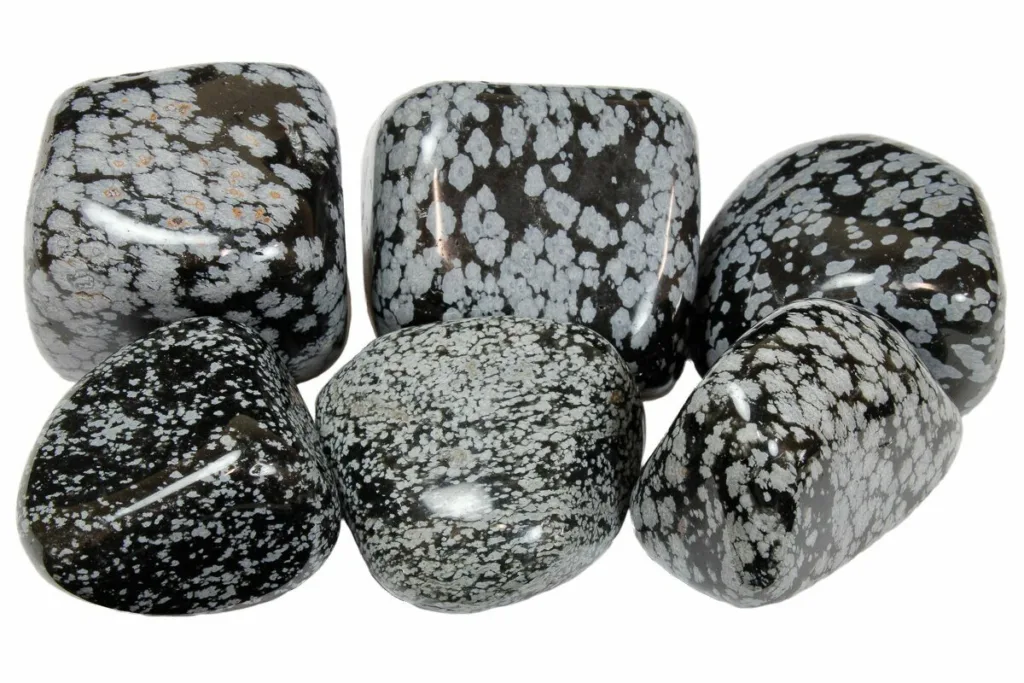
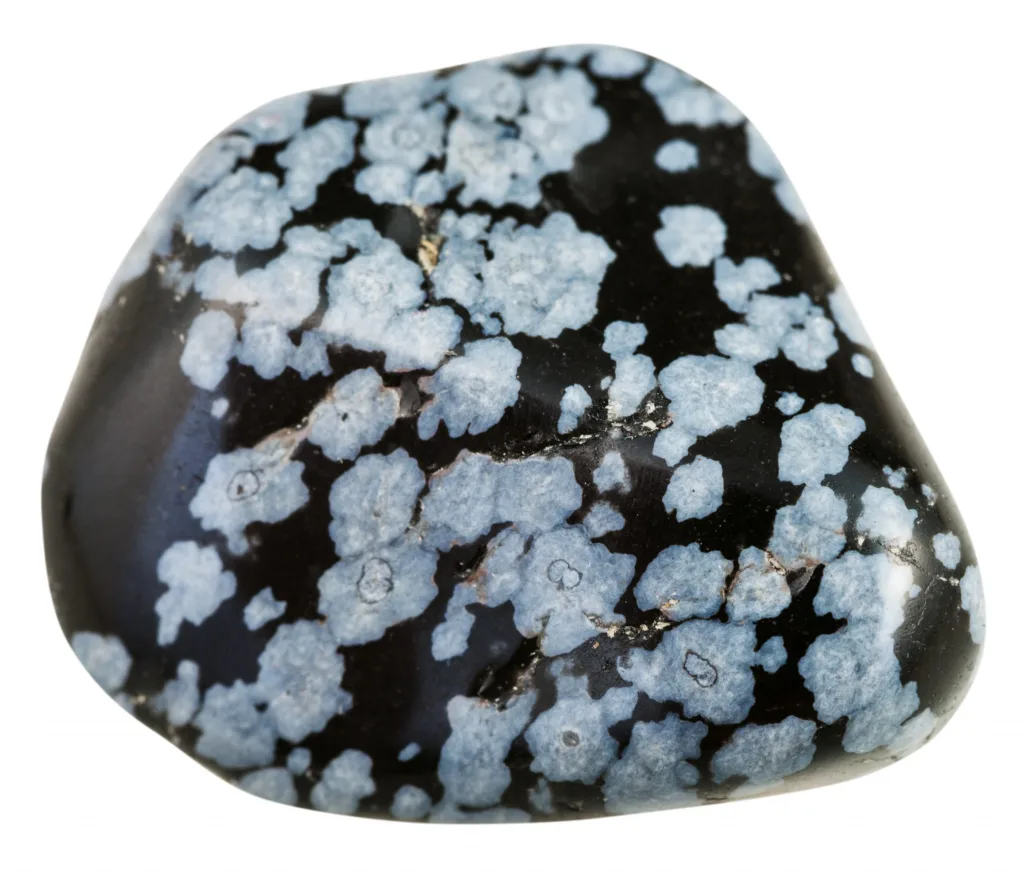
Obsidian itself is formed when lava cools quickly and solidifies without crystallizing. The addition of these snowflake-like patterns distinguishes Snowflake Obsidian from other types of obsidian. The name “obsidian” is derived from the ancient Roman explorer Obsius, who is said to have discovered a similar volcanic glass in Ethiopia.
Beyond its aesthetic appeal, Snowflake Obsidian has been used for various purposes throughout history. In the realm of metaphysics and spirituality, it is believed to have grounding and protective properties. Some people use it for meditation and spiritual work, associating it with balance and the integration of opposites.
It’s important to note that while Snowflake Obsidian has cultural and spiritual significance for some, its use in these contexts is not universally accepted, and individual experiences with the stone can vary. As with any gemstone or crystal, beliefs and practices associated with Snowflake Obsidian can be subjective and depend on personal perspectives.
Geological Formation of Snowflake Obsidian

Snowflake Obsidian, like other types of obsidian, is formed through volcanic processes. Here’s a brief overview of the geological formation of Snowflake Obsidian:
- Volcanic Activity:
- Snowflake Obsidian is primarily created through the rapid cooling of lava. Volcanic activity results in the expulsion of molten rock, or lava, from the Earth’s mantle onto the surface.
- Composition:
- Rapid Cooling:
- Unlike many other rocks and minerals that form through slow cooling and crystallization, obsidian forms when lava cools rapidly. The quick cooling inhibits the crystalline structure from developing, resulting in an amorphous (non-crystalline) structure.
- Glassy Texture:
- The rapid cooling process prevents the formation of large crystals, giving obsidian its glassy texture. The lack of a crystalline structure is a distinguishing feature of obsidian.
- Inclusions:
- In the case of Snowflake Obsidian, the distinctive white or grayish “snowflake” patterns are caused by the presence of internal crystallites, often composed of the mineral cristobalite. These inclusions form as the lava cools and solidifies.
- Phenocrysts:
- The snowflake-like patterns are essentially phenocrysts within the obsidian. Phenocrysts are larger crystals that are embedded in a finer-grained matrix.
- Formation of Cristobalite:
- Cristobalite is a high-temperature polymorph of quartz, and its presence in the obsidian results from specific conditions during the cooling process.
- Erosion and Exposure:
- Over time, geological processes such as erosion and weathering expose the obsidian to the surface. This allows for the collection and extraction of Snowflake Obsidian by humans.
The unique combination of volcanic activity, rapid cooling, and the presence of specific minerals like cristobalite contributes to the formation of Snowflake Obsidian with its characteristic appearance. The intricate patterns within the black or dark brown matrix make it a popular and visually striking variety of obsidian used in various applications, including jewelry and spiritual practices.
Physical Properties of Snowflake Obsidian

The physical properties of Snowflake Obsidian are characteristic of volcanic glass and share similarities with other types of obsidian. Here are some key physical properties:
- Color:
- Snowflake Obsidian has a predominantly black or dark brown color, and its distinctive feature is the presence of white to grayish “snowflake” patterns created by inclusions of cristobalite.
- Luster:
- The luster of Snowflake Obsidian is typically shiny and glassy due to its amorphous, non-crystalline structure.
- Transparency:
- Snowflake Obsidian is generally opaque, meaning that light does not pass through it.
- Hardness:
- It has a hardness of approximately 5 to 5.5 on the Mohs scale. This means it is moderately hard and can be scratched by harder minerals but can scratch softer ones.
- Density:
- The density of Snowflake Obsidian varies but is generally around 2.35 to 2.40 grams per cubic centimeter.
- Cleavage and Fracture:
- Obsidian does not exhibit cleavage because it lacks a crystalline structure. Instead, it typically shows conchoidal fracture, characterized by smooth, curved, shell-like surfaces when broken. This fracture pattern is a result of the way the volcanic glass breaks along curved surfaces.
- Specific Gravity:
- The specific gravity of Snowflake Obsidian ranges from approximately 2.35 to 2.40, which is slightly higher than the average for most minerals.
- Toughness:
- Obsidian is known for its toughness. Despite its glassy appearance, it is less brittle than true glass. This toughness is due to its lack of cleavage and its ability to absorb stress before breaking.
- Tenacity:
- Snowflake Obsidian has a tenacious character, meaning it is resistant to breaking or shattering.
- Inclusions:
- The distinctive white or grayish “snowflake” patterns in Snowflake Obsidian are caused by inclusions of cristobalite, which is a polymorph of quartz.
These physical properties contribute to the unique appearance and durability of Snowflake Obsidian, making it a popular material for jewelry, carvings, and other ornamental uses. Additionally, its metaphysical properties and symbolism often enhance its desirability in the spiritual and healing communities.
Historical and Cultural Significance
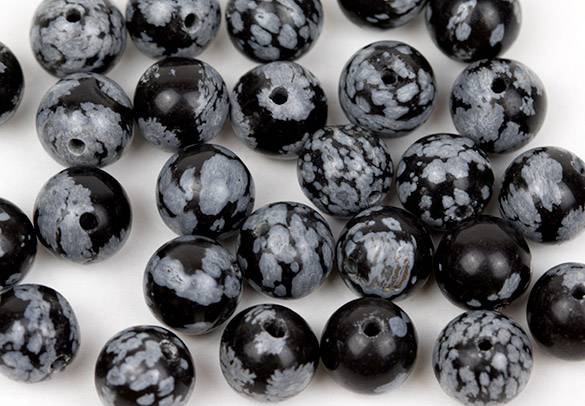
Snowflake Obsidian, like other forms of obsidian, has historical and cultural significance across various ancient cultures. Its use dates back thousands of years, and it has been valued for both practical and symbolic purposes. Here are some aspects of its historical and cultural significance:
- Toolmaking:
- In ancient times, obsidian, including Snowflake Obsidian, was highly prized for its sharp edges when fractured. It was used by many cultures for toolmaking, such as for crafting arrowheads, blades, and other cutting instruments. The ability of obsidian to fracture into extremely sharp pieces made it a valuable material for practical applications.
- Ceremonial and Decorative Use:
- Snowflake Obsidian, with its striking contrast of black and white patterns, has been used decoratively in various cultures. It often found its way into ceremonial objects, jewelry, and ornaments. The unique appearance made it aesthetically appealing for both practical and symbolic reasons.
- Spiritual and Metaphysical Beliefs:
- In metaphysical and spiritual practices, Snowflake Obsidian is often associated with grounding, protection, and balance. Some believe that its black color symbolizes the depth of the subconscious, while the white “snowflake” patterns represent purity and the ability to see things with clarity.
- Native American Cultures:
- Obsidian, including Snowflake Obsidian, holds particular significance in Native American cultures. It was used for creating tools and weapons, and its use is embedded in the cultural and spiritual practices of various tribes. Additionally, it was sometimes used in ceremonies and rituals.
- Aztec Culture:
- In ancient Aztec culture, obsidian had ceremonial and symbolic importance. The Aztecs crafted intricate ritual knives, known as “tecpatl,” from obsidian, which were used in sacrifices.
- Mayan Culture:
- Mayans also used obsidian for tools and weapons. Obsidian blades were highly effective for various tasks, including cutting and piercing.
- Protection and Healing:
- Across different cultures, Snowflake Obsidian has been considered a stone of protection. Some believe that it can help absorb negative energies and promote emotional healing. It is often used in meditation and spiritual practices to enhance self-awareness and balance.
- Modern Metaphysical Practices:
- In contemporary metaphysical practices, Snowflake Obsidian continues to be popular for its grounding properties. It is believed to assist in recognizing and releasing harmful thought patterns, promoting clarity, and providing a sense of balance.
It’s important to note that beliefs and practices associated with Snowflake Obsidian can vary widely among individuals and cultural traditions. While some view it through a spiritual or metaphysical lens, others appreciate it for its geological and aesthetic qualities. Regardless of the interpretation, Snowflake Obsidian has maintained a connection with human cultures for its unique combination of visual appeal and perceived metaphysical attributes.
Sources – Where it is Found
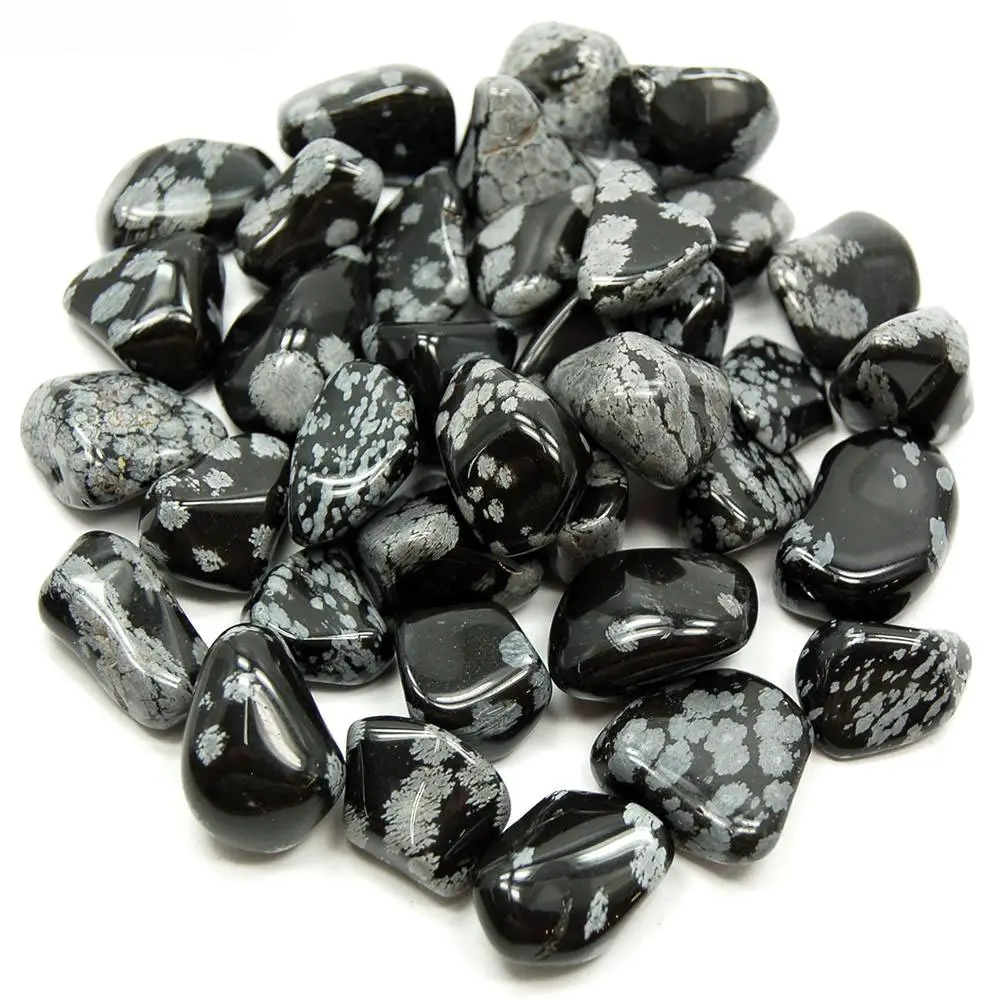
As of my last knowledge update in January 2022, Snowflake Obsidian, like other types of obsidian, can be found in various locations around the world. However, the availability of Snowflake Obsidian is not as widespread as some other varieties of obsidian. Here are a few general sources where Snowflake Obsidian can be found:
- United States:
- Snowflake Obsidian is known to occur in the United States. Specific locations include the western states such as Oregon, California, and Nevada. In these regions, volcanic activity has led to the formation of obsidian, including the snowflake variety.
- Mexico:
- Mexico is another source of Snowflake Obsidian. Volcanic regions in Mexico have deposits of obsidian, and some of it may display the characteristic snowflake patterns.
- Other Locations:
- While the primary sources are in North America, Snowflake Obsidian or similar varieties may also be found in other volcanic regions globally.
Mining and extraction of Snowflake Obsidian involve processes similar to those used for other types of obsidian. Here’s a general overview:
- Identification of Deposits:
- Geological surveys and studies are conducted to identify regions with obsidian deposits, including areas where Snowflake Obsidian may be found. These deposits are often associated with past or present volcanic activity.
- Prospecting:
- Once potential deposits are identified, prospecting involves on-site exploration to assess the quality and quantity of the obsidian. This may include surface mapping and sampling.
- Mining Techniques:
- Mining obsidian involves the extraction of the volcanic glass from the earth. Various techniques can be employed, ranging from surface mining to underground mining, depending on the depth and distribution of the deposits.
- Extraction:
- Obsidian is extracted by breaking and removing the surrounding rock to access the obsidian layers. Hand tools and sometimes machinery are used in this process.
- Transportation:
- Extracted obsidian is then transported to processing facilities. The transportation methods can vary, and it may involve trucks, conveyor belts, or other means depending on the scale of mining operations.
- Processing and Shaping:
- Once at the processing facility, the raw obsidian is cleaned, shaped, and prepared for various uses. For Snowflake Obsidian, the distinctive patterns are already present in the raw material, and the stone is often shaped into beads, cabochons, or other forms for jewelry and ornamental purposes.
It’s important to note that the mining and extraction processes must comply with environmental regulations to minimize the impact on ecosystems and surrounding areas. Additionally, the information provided here is a general overview, and specific details may vary based on the location and scale of mining operations. If you are interested in specific sources or current information, it’s advisable to consult geological surveys, mining industry reports, or relevant authorities in the regions where Snowflake Obsidian is known to occur.
Uses and Applications of Snowflake Obsidian
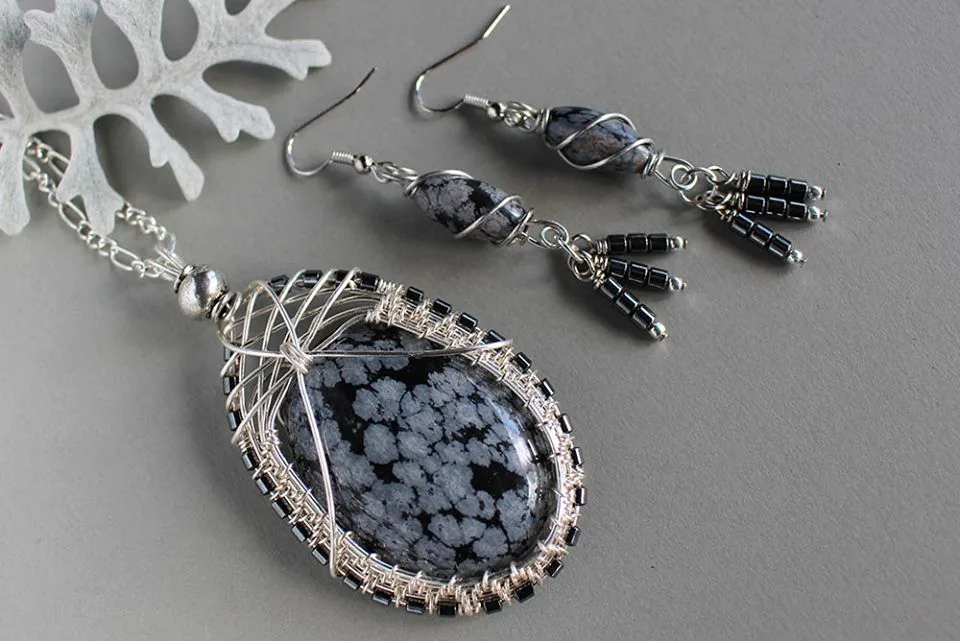
Snowflake Obsidian, with its distinctive appearance and unique properties, finds various uses and applications, both practical and symbolic. Here are some common uses and applications:
- Jewelry:
- Snowflake Obsidian is a popular choice for jewelry due to its attractive black and white contrast. It is often crafted into beads, cabochons, pendants, and other jewelry pieces. The distinctive snowflake patterns make it particularly eye-catching.
- Ornamental Carvings:
- The unique appearance of Snowflake Obsidian makes it a sought-after material for ornamental carvings. Sculptors and artisans create intricate carvings, sculptures, and decorative items that showcase the stone’s natural beauty.
- Metaphysical and Spiritual Practices:
- In metaphysical and spiritual practices, Snowflake Obsidian is believed to have grounding and protective properties. It is often used in meditation and energy work to enhance self-awareness, balance, and clarity of thought.
- Healing Stones:
- Some individuals believe that Snowflake Obsidian has healing properties and can aid in emotional healing and overcoming negative thought patterns. It is used as a gemstone for holistic well-being.
- Ceremonial and Ritual Objects:
- Snowflake Obsidian, like other types of obsidian, has been historically used in ceremonial and ritual objects. It may be incorporated into amulets, talismans, or other items with symbolic significance in various cultural and spiritual traditions.
- Lapidary Art:
- Lapidaries, individuals skilled in the art of cutting and shaping gemstones, often work with Snowflake Obsidian to create custom designs. The stone’s hardness and unique patterns make it suitable for lapidary art.
- Decoration and Interior Design:
- Snowflake Obsidian may be used for decorative purposes in interior design. Tiles, countertops, and other surfaces made from Snowflake Obsidian can add a touch of natural beauty to spaces.
- Educational and Geological Studies:
- Obsidian, including Snowflake Obsidian, is of interest to geologists and researchers studying volcanic processes. The study of its formation and composition contributes to a better understanding of Earth’s geological history.
- Gifts and Collectibles:
- Due to its aesthetic appeal and cultural significance, Snowflake Obsidian is often chosen as a meaningful gift or collected as a unique gemstone.
- Personal Accessories:
- Beyond jewelry, Snowflake Obsidian may be used in the creation of various personal accessories, such as keychains, amulets, and other items that people carry for their visual appeal or symbolic significance.
It’s important to note that beliefs and practices associated with the metaphysical and healing properties of Snowflake Obsidian can vary widely among individuals and spiritual traditions. Whether used for its aesthetic appeal, cultural significance, or perceived metaphysical properties, Snowflake Obsidian has maintained its popularity across a range of applications.




































